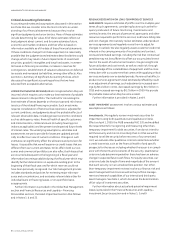GE 2011 Annual Report Download - page 56
Download and view the complete annual report
Please find page 56 of the 2011 GE annual report below. You can navigate through the pages in the report by either clicking on the pages listed below, or by using the keyword search tool below to find specific information within the annual report.’
54 GE 2011 ANNUAL REPORT
December 31, 2011, primarily as a result of collections and write-
offs of nonearning receivables in our asset-based fi nancing
businesses in Japan, Australia and New Zealand. The ratio of
nonearning receivables as a percent of fi nancing receivables
decreased from 3.4% at December 31, 2010, to 2.3% at
December 31, 2011, primarily due to the decline in nonearning
receivables related to our asset-based fi nancing businesses in
Japan, Australia and New Zealand, partially offset by a lower
fi nancing receivables balance. Collateral supporting these non-
earning fi nancing receivables is primarily commercial real estate,
manufacturing equipment, corporate aircraft, and assets in the
auto industry.
REAL ESTATE—DEBT. Nonearning receivables of $0.5 billion repre-
sented 5.8% of total nonearning receivables at December 31,
2011. The decrease in nonearning receivables from December 31,
2010, was driven primarily by the resolution of U.S. multi-family
and offi ce nonearning loans, as well as European hotel and retail
loans, through restructurings, payoffs and foreclosures, partially
offset by new European multi-family delinquencies. The ratio of
allowance for losses as a percent of nonearning receivables
increased from 134.4% to 175.4% refl ecting resolution of non-
earning loans as mentioned above. The ratio of allowance for
losses as a percent of total fi nancing receivables decreased from
4.3% at December 31, 2010 to 3.9% at December 31, 2011, driven
primarily by write-offs related to settlements and payoffs from
impaired loan borrowers and improvement in collateral values.
The Real Estate fi nancing receivables portfolio is collateralized
by income-producing or owner-occupied commercial properties
across a variety of asset classes and markets. At December 31,
2011, total Real Estate fi nancing receivables of $32.7 billion were
primarily collateralized by owner-occupied properties ($8.2 billion),
offi ce buildings ($7.2 billion), apartment buildings ($4.5 billion) and
hotel properties ($3.8 billion). In 2011, commercial real estate mar-
kets showed signs of improved stability and liquidity in certain
markets; however, the pace of improvement varies signifi cantly
by asset class and market and the long term outlook remains
uncertain. We have and continue to maintain an intense focus on
operations and risk management. Loan loss reserves related to our
Real Estate—Debt fi nancing receivables are particularly sensitive to
declines in underlying property values. Assuming global property
values decline an incremental 1% or 5%, and that decline occurs
evenly across geographies and asset classes, we estimate incre-
mental loan loss reserves would be required of less than $0.1 billion
and approximately $0.2 billion, respectively. Estimating the impact
of global property values on loss performance across our portfolio
depends on a number of factors, including macroeconomic condi-
tions, property level operating performance, local market dynamics
and individual borrower behavior. As a result, any sensitivity
analyses or attempts to forecast potential losses carry a high
degree of imprecision and are subject to change. At December 31,
2011, we had 119 foreclosed commercial real estate properties
totaling $0.7 billion.
CONSUMER—NON-U.S. RESIDENTIAL MORTGAGES. Nonearning
receivables of $3.3 billion represented 36.0% of total nonearn-
ing receivables at December 31, 2011. The ratio of allowance for
losses as a percent of nonearning receivables decreased from
21.5% at December 31, 2010, to 21.1% at December 31, 2011. In
the year ended 2011, our nonearning receivables decreased
primarily due to improving portfolio quality in the U.K. Our non-
U.S. mortgage portfolio has a loan-to-value ratio of approximately
75% at origination and the vast majority are fi rst lien positions.
Our U.K. and France portfolios, which comprise a majority of our
total mortgage portfolio, have reindexed loan-to-value ratios of
84% and 56%, respectively. About 4% of these loans are without
mortgage insurance and have a reindexed loan-to-value ratio
equal to or greater than 100%. Loan-to-value information is
updated on a quarterly basis for a majority of our loans and con-
siders economic factors such as the housing price index. At
December 31, 2011, we had in repossession stock 461 houses in
the U.K., which had a value of approximately $0.1 billion. The ratio
of nonearning receivables as a percent of fi nancing receivables
remained constant at 9.3% at December 31, 2011.
CONSUMER—NON-U.S. INSTALLMENT AND REVOLVING CREDIT.
Nonearning receivables of $0.3 billion represented 2.8% of total
non earning receivables at December 31, 2011. The ratio of allow-
ance for losses as a percent of nonearning receivables decreased
from 324.2% at December 31, 2010 to 272.6% at December 31,
2011, refl ecting the effects of loan repayments and reduced
originations primarily in our European platforms.
CONSUMER—U.S. INSTALLMENT AND REVOLVING CREDIT. Nonearn-
ing receivables of $1.0 billion represented 10.6% of total non earning
receivables at December 31, 2011. The ratio of allowance for losses
as a percent of nonearning receivables increased from 194.3% at
December 31, 2010, to 202.8% at December 31, 2011, as a result
of lower entry rates and improved collections resulting in reduc-
tions in our nonearning receivables balance. The ratio of
nonearning receivables as a percentage of fi nancing receivables
decreased from 2.7% at December 31, 2010 to 2.1% at
December 31, 2011, primarily due to lower delinquencies refl ect-
ing an improvement in the overall credit environment.
























